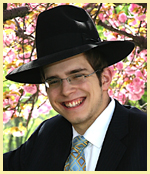Happiness is Key
[Editor’s note: As a memory of my beloved brother Shaya, I would like to continue sending out his pearls of wisdom that he has shared with all of you in the past. For some of you this may ring a bell and for others it may appear to be totally new. May the learning of Shaya’s Divrei Torah inspire us to change our ways and thereby give an Aliya to the neshama of our dear beloved Shaya whom we miss so much.]
Parshas Ki Sisa tells of Moshe being on the mountain and Hashem telling Moshe that the Jews sinned with the Golden Calf. Yet it was only when Moshe approached the camp and saw the calf and the Jews dancing, that he decided to break the tablets. Why did Moshe wait to break the tablets until after coming down the mountain and not immediately after hearing from Hashem that the Jewish People had sinned?
One answer is that Moshe was aware that the Jewish people had sinned, but it wasn’t until he came down from the mountain, that he saw that they were DANCING with the calf. A person dances when [s]he is happy and filled with joy, so obviously they were enjoying themselves. Now it’s one thing to sin, but when one gets a ‘geshmak’ [pleasure] in the sin, that’s a lot worse, because when you enjoy something you connect to it and become attached to it. That is why Moshe only decided to break the tablets when he actually came down and saw them dancing with the Calf.
The Seforim tell us that just about all character traits have a ‘tzad hatov.’ Meaning that instead of stunting the character trait that we use in a bad way, we should try to channel it for the good.
Simcha as well works both ways. Studying Torah, Davening, and doing Mitzvos with joy is an extremely important part of Judaism. Not only is it okay to enjoy the Mitzvos that we do, it is an extremely integral part of the Mitzva. All for the same reason that when you enjoy something, you connect to it, love it, and continue to do it. At the same time, it can be used for the bad as we see in our parsha that the Jewish People connected to the Calf through Simcha.
The holy Seforim tell us that whenever we see the word ‘Hamelech’ [the king] in Megillas Esther, besides for referring in the simple understanding to Achashveirosh, it also has a deeper meaning in reference to Hashem, the King of all kings. Some of them are more easily understood, while others may elude us and require deeper understanding to reveal the meaning to us.
Here’s one of the easier understood ones. The Pasuk says when Mordechai was going towards the palace in sackcloth, ‘he came until the front of the king’s gate for it is forbidden to enter the king’s gate clothed in sackcloth.”
The Pasuk is telling us that you cannot enter the palace of Hashem with sackcloth. This means that the most authentic form of connection to Hashem is not with sadness or fear [denoted by the term sackcloth and the obvious sadness and fear that Mordechai was in at that time] but rather with joy and love for Hashem.
Now as Purim Katon has just passed and we are gearing up to Purim, let us all channel the special Simcha that is, ‘in the air,’ towards Avodas Hashem. Perhaps this will be [part of] our share in rectifying the sin of the Golden Calf. May we all have a wonderful uplifting year filled with rejuvenation of joy and passion in our service of Hashem.
{Editor’s note: As I read through this dvar torah I couldn’t help but see Shaya in every word. This is something that Shaya stood for!
The most common response one would get if they would ask anyone what they remember from Shaya would be without a doubt “his trademark smile that when he would beam it at you would make you feel like a million bucks and his Simchas Hachayim for life!”
One of Shaya’s favorite Yomim Tovim was Simchas Torah where he would dance with such joy and simcha that everyone would join in just to dance with Shaya. But really it wasn’t just Simchas Torah, it was all Yomim Tovim and all Mitzvohs! He had such a joy for all Mitzvohs that would be so contagious that everyone else would get in the mood as well.
I still remember how Shaya would make even the minute aspect of a Mitzvah like searching for chometz or finding the Afikomen into such a fun game.
Shaya also had a tremendous Simcha for life. When he smiled, everyone smiled with him. When he smiled at people, he created a connection with them, which lasted a lifetime. When Shaya would come to a Chasunah he danced with such joy and simcha that invariably everyone else would be swept up with such joy and join in.
As we get into the spirit of Purim, let us try to perpetuate Shaya’s legacy that he left us; to always be happy and make others happy, enjoy life and to do all of the Mitzvohs with Simcha!}
To be added to the weekly Dvar Torah list please email zichronshaya@gmail.com



